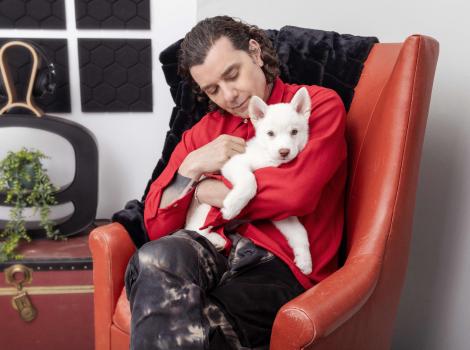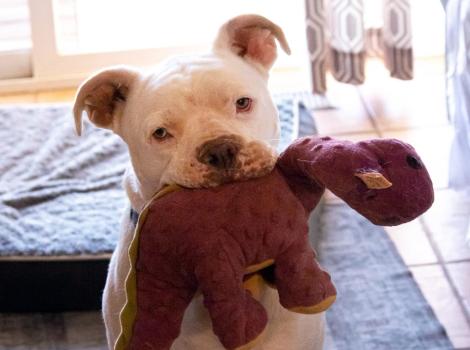Time, training, and love transform nervous dog

Once upon a time there lived a beautiful, raven-haired dog named Valley, who longed for freedom. She was locked away, metaphorically, high in a tower made of her own anxiety. No matter how hard she tried, she just couldn’t escape the tower. She paced and she paced. She dreamed of carefree romping through sand and over red-rock mesas with friends, throwing off the shackles of fear and embracing life to the fullest.
Then, one fateful day, her wish came true. She met the dog behavior team at Best Friends Animal Sanctuary along with caregiver Emma Odekirk. Together, they found the key to unlocking Valley’s tower: time, love, and gentle guidance.
Best Friends’ goal is for all shelters to reach no-kill in 2025, and one thing that means is giving pets like Valley the personalized care and training they need to be matched with new homes.

Calming lessons
Emma employed a variety of techniques to help Valley overcome her nervousness about, well, nearly everything. “Valley was reactive to almost anything — cars, dogs, you name it — whenever we walked past,” says Emma. “She was always barking at other animals.”
[Reactive dog just needed understanding]
Leashes and barriers, such as fences or doors, also ignited her anxiety, resulting in more frantic barking. To address these issues, Emma used redirection to guide Valley toward better behaviors. “When she saw something she wanted to react to, I would ask her to sit and check in with me instead,” Emma explains.

Walks for the win
Valley's progress was remarkable; she went from reacting to dogs and cars nearly all the time to rarely reacting. With this improvement, Emma could advance to the next phase of Valley’s training: parallel walks and playgroups.
A parallel walk is a training technique where two dogs are walked side by side at a comfortable distance from each other. The goal is to desensitize dogs to the presence of other dogs, helping them build positive associations and calming their nerves.
“We worked on just minding her own business and not reacting to that other dog,” Emma says. “And then once she had that down, I reached out to our behavior team and asked if we could do a playgroup with other dogs.”
While Valley was a bit awkward with the other dogs at first, she quickly got the hang of it and loved playing with other dogs. Barks of joy rather than anxiety filled the air as Valley discovered that other animals weren’t so scary after all.

Tower of transformation
“After she proved she could get along with other dogs, I started seriously thinking about adopting her,” says Emma. “I took her on a sleepover to see how she got along with my cats. She didn’t care about my cats — she even tried to get them to play. She loved it and made herself right at home. I adopted her not long after that.”
Valley’s tower completely crumbled, leaving all her anxiety (and frantic barking) in the dust. She was home. But that’s not the end of Valley’s transformative journey. Her confidence continued to flourish in Emma’s home and under her gentle guidance. Soon, Valley’s social calendar burgeoned with play dates, walks with friends, and fostering puppies.
“Now she does playgroups with other dogs who need to get some energy out and does so well,” says Emma. “That's part of the reason why I chose to foster puppies. I knew she would be able to handle their energy level and teach the puppies what it’s like to be a dog. Plus, she needed someone to consistently play with.”
[Magic of playgroups unveils dogs’ hidden sociability]
It turns out Valley was born to foster puppies. “She loves them,” says Emma. “She teaches them how to play tug-of-war and how to wrestle. And I always see them cuddling on the couch together.”
Valley has come full circle. From a lonely tower of anxiety, she now roams free, confident and full of joy. This dog who once barked at everything and everyone now walks calmly alongside others, helping puppies learn how to be dogs and cuddling with kitties. Valley has broken free from her tower — and she’s helping others find their way out of their own towers, too.

Let's make every shelter and every community no-kill in 2025
Our goal at Best Friends is to support all animal shelters in the U.S. in reaching no-kill in 2025. No-kill means saving every dog and cat in a shelter who can be saved, accounting for community safety and good quality of life for pets.
Shelter staff can’t do it alone. Saving animals in shelters is everyone’s responsibility, and it takes support and participation from the community. No-kill is possible when we work together thoughtfully, honestly, and collaboratively.






